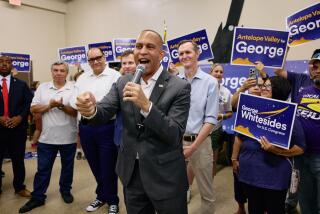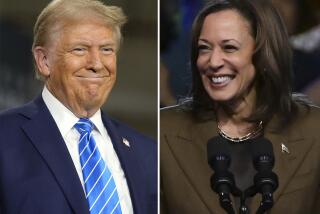Inroads Into GOP Country
WASHINGTON — America does not get much more Republican than Idaho. President Bush pulled in 68% of the vote in 2004, and the state has an all-GOP congressional delegation.
But to keep one of Idaho’s House seats in Republican hands, the national GOP in recent weeks has poured in hundreds of thousands of dollars for television ads and brought in a parade of party bigwigs to campaign.
Such a huge effort in a district that should be a cakewalk for Republicans is a measure of how deep into GOP territory the fight for control of Congress has reached.
Over the last two months, the number of House Republican seats in serious contention has jumped week by week, giving Democrats an ever-bigger target to shoot at in their quest for a majority. Even a top Republican strategist estimates that the number of highly vulnerable Republican seats has more than doubled in recent weeks -- and now far exceeds the 15 seats Democrats need to pick up to win a House majority.
“Things look very bad for them now,” GOP pollster Frank Luntz said of Republican prospects. “There used to be 15 races that were vulnerable, then it was 20.... Today you’d say 35 seats are in play.”
In the battle for the Senate, prospects for Democrats to pick up the six seats they need to win control are brighter than they were a few months ago.
All that reflects an unusually fluid political landscape that has sent candidates, party leaders and interest groups scrambling to recalibrate strategy. The Republican Party has dropped plans for ads in South Carolina and other areas they now consider lost causes. The AFL-CIO has opened fronts in its $40-million get-out-the-vote drive in Tennessee and Virginia, reflecting the union’s assessment that Democratic chances have improved there. National Democratic leaders are taking greater interest in districts in California and Minnesota, where newly strengthened candidates need support.
“It’s hard to keep track of the new races that are looking very competitive,” said Rep. Chris Van Hollen (D-Md.), vice chairman of the committee responsible for electing Democrats to the House. “They are popping up all over the place.”
Bush will be doing his part for Republicans today, campaigning for two incumbents who are in worse political shape than they were just two months ago: Sen. George Allen of Virginia, who had been expected to coast to reelection but is now less assured after a series of missteps; and Rep. Don Sherwood of Pennsylvania, who is fighting for political survival amid accusations that he tried to choke his mistress in 2004.
The president has remained publicly upbeat about Republicans’ prospects, despite the bruising the party has taken over the congressional page sex scandal, sectarian violence in Iraq and criticism of Bush’s handling of the North Korean nuclear threat.
But privately, GOP anxiety is growing -- especially among House Republicans who believe their leaders’ handling of the page scandal surrounding former Rep. Mark Foley (R-Fla.) has made a bad situation worse. After listening in on a telephone conference call among House Republicans last week, Luntz said, “The bitterness about how the leadership has handled Foley is indescribable.”
In more evidence of the challenge facing Republicans, a new poll found that voter support for the party and its continued leadership of Congress had sunk below the level Democrats saw before they lost control of the House and Senate in 1994.
The Wall Street Journal/NBC News poll, released Wednesday, pegged voter approval of Congress at 16%, matching its lowest point since the House bank scandal of 1992 that set the stage for Democrats to lose their majorities. Voters in the new survey also said they preferred Democrats over Republicans to control Congress, 52% to 37% -- a gap that, according to a Wall Street Journal account, far exceeds the 6-point lead that Republicans enjoyed just before taking control of Congress in 1994.
The poll included 1,006 registered voters and carried a margin of error of 3.1 percentage points.
Still, some analysts say Republicans could reduce their losses in the final weeks of the campaign if the spotlight moves to issues that play to GOP strengths, such as the war on terrorism and falling gasoline prices.
“The spotlight could shift another time or two before Nov. 7,” said Charles Cook, editor of the nonpartisan Cook Political Report.
For some time, the House has seemed much more likely than the Senate to turn Democratic. That was in part because most of the competitive Senate races were in conservative-leaning states, such as Montana, Missouri and Tennessee -- thought to be tough terrain for Democrats. Not long ago, only two incumbent Republicans in Democratic-leaning states seemed ripe for picking: Rick Santorum in Pennsylvania and Lincoln Chafee in Rhode Island.
In recent months, however, developments have made it easier to imagine Democrats winning the six seats they are looking for. Some analysts have practically written off Montana, where Republican Sen. Conrad Burns has been under fire for his links to disgraced former GOP lobbyist Jack Abramoff. Democrats are running close to or ahead of Republican opponents in four other key states: Ohio, Tennessee, Virginia and Missouri.
In the final three weeks of the campaign, both parties will be deciding on almost a daily basis how to allocate resources. “This is a very fluid process,” said Brian Nick, spokesman for the National Republican Senatorial Committee.
Republicans are debating how much money to pour into Ohio. GOP Sen. Mike DeWine is trailing his Democratic opponent by double digits and may be a lost cause. But the state has several competitive House races that would be hurt if the national party pulled back.
Republicans also face a choice about how much to invest in New Jersey, where Sen. Robert Menendez is about the only incumbent Democratic senator who seems at risk.
The Democratic Senatorial Campaign Committee this week put up its first ad for him. Republicans transferred $500,000 to help GOP challenger Tom Kean Jr. pay for ads. But it remains to be seen whether the GOP will make a further commitment to this heavily Democratic state.
The battle for the House is even more fluid. The Cook Political Report’s count of the most hotly contested Republican seats has hit 43, up from 35 in early September.
In the GOP stronghold of Idaho, an especially surprising contest is brewing. In a race to succeed Republican Rep. C.L. “Butch” Otter, a bitter GOP primary was won by state legislator William Sali, who has been at odds with the state party establishment and has had trouble raising money.
The National Republican Congressional Committee this week weighed in with an ad attacking Democrat Larry Grant. The airtime it bought was worth $377,000 over three weeks, according to a survey of local stations by Grant’s media consultant, Peter Fenn. To further boost the Republican, Vice President Dick Cheney, Republican National Committee Chairman Ken Mehlman and House Speaker J. Dennis Hastert (R-Ill.) have campaigned there.
“If someone had told me six months ago that Republicans would bring in the vice president, the speaker of the House and the Republican chairman in a month and a half’s time, I would have said they were stark raving crazy,” Fenn said.
Meanwhile, Republicans have pulled back most of their efforts to challenge Democratic incumbents such as Rep. John M. Spratt Jr. of South Carolina and Alan B. Mollohan of West Virginia. The GOP campaign committee has given back airtime it had reserved for those races, as well as for two open seats in Ohio.
Democrats are juggling candidates’ demands for attention and resources. The Democratic Congressional Campaign Committee has begun listing “emerging campaigns” to encourage donors to give to promising candidates.
Among them is Charlie Brown, the Democrat challenging Rep. John T. Doolittle (R-Roseville), who has been under scrutiny for his reported links to Abramoff, the former lobbyist. Although that is a solidly Republican district, Democratic Party leaders are now encouraging safe incumbents to donate to Brown. Earlier this week, House Democratic Leader Nancy Pelosi (D-San Francisco) headlined a fundraiser for him.
The Democratic campaign committee is also taking new aim in Minnesota, where Republican Rep. Gil Gutknecht had been favored to win reelection. Encouraged by recent polls, the committee plans to air an ad against him.
The midterm campaign now heads into a final stretch that plays to a Republican strength: the party’s much-vaunted ability to get its voters to the polls. Danny Diaz, a spokesman for the Republican National Committee, said the party would spend $60 million for get-out-the-vote efforts and other endgame programs.
But Democratic activists are poised as well. In addition to the AFL-CIO’s get-out-the-vote drive, the liberal group MoveOn.org, which began with plans to target about 30 congressional races, now plans to make phone calls targeting as many as 50.
Some Democrats fear they will not have enough money to take full advantage of the political opportunity. But Pelosi, speaking during a day of West Coast fundraising, said she had brought in more money than expected.
“People are very optimistic about our prospects,” she said.
*
Times staff writers Faye Fiore and Mima Mohammed contributed to this report.
*
(BEGIN TEXT OF INFOBOX)
Battle for the House
The present House division favors Republicans, but many seats are in play, with enough rated tossups to swing the balance of power.
Current division
Republicans: 232
Democrats: 203
Note: Republican total includes two vacant seats; Democratic total includes one independent and one vacancy.
*
Election forecast
Republicans: 209
Leaning: 19
Favored: 26
Safe: 164
--
Democrats: 209
14 Leaning
12 Favored
183 Safe
--
Tossups 17
*
Source: Congressional Quarterly
More to Read
Get the L.A. Times Politics newsletter
Deeply reported insights into legislation, politics and policy from Sacramento, Washington and beyond. In your inbox three times per week.
You may occasionally receive promotional content from the Los Angeles Times.











